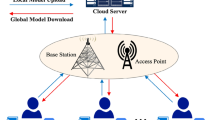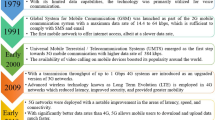Abstract
Recently, the Non-Standalone Architecture option 3 standard is proposed to facilitate the deployment of 5th Generation (5G) New Radio (NR) cellular systems. According to this standard, 5G NR base stations can utilize the 4th Generation (4G) Long-Term Evolution (LTE) core network to provide network services. Additionally, the network can be configured to support LTE-NR dual connectivity enhancement, which means that a User Equipment (UE) can connect to a 4G LTE and a 5G NR base station at the same time. In such a dual connectivity network, the 4G LTE base station dispatches downlink traffic flows between the 4G LTE and 5G NR base stations for UEs. As investigated in previous works, traffic flow controls between 4G LTE and 5G NR base stations will affect network performance. In this work, we propose a downlink flow control algorithm based on the concept of Genetic Algorithm, with the objectives of maximizing throughput and fairness of throughput. We verify our designs through simulation programs and experiments on real platforms. The results indicate that the proposed solution effectively achieves the designed objectives.











Similar content being viewed by others
Data Availability
Not applicable.
References
Baratè, A., Haus, G., Ludovico, L. A., Pagani, E., & Scarabottolo, N. (2019). 5G technology for augmented and virtual reality in education. In Proceedings of International Conference on Education and New Developments.
Rao, S. K., & Prasad, R. (2018). Impact of 5G technologies on smart city implementation. Wireless Personal Communications, 100(1), 161–176.
Yilmaz, O. N. C., Teyeb, O., & Orsino, A. (2019). Overview of LTE-NR dual connectivity. IEEE Communications Magazine, 57(6), 138–144.
Liu, S. (2020). Critical business decision making for technology startups: A perception case study. IEEE Engineering Management Review, 48(4), 32–36.
“4G; LTE; Radio Access Network (E-UTRAN), S1 general aspects and principles, 3GPP TS 36.410 version 15.0.0 Release 15” (2018). Technical Specification (TS).
“4G; LTE; Radio Access Network (E-UTRAN); X2 general aspects and principles, 3GPP TS 36.420 version 15.0.0 Release 15” (2018). Technical Specification (TS).
Sylla, T., Mendiboure, L., Maaloul, S., Aniss, H., Chalouf, M. A., & Delbruel, S. (2022). Multi-connectivity for 5G networks and beyond: A survey. Sensors, 22(19), 7591.
Cui, H., & Du, Y. (2023). Joint user association and fair scheduling for dual connectivity heterogeneous networks. China Communications, 20(1), 171–183.
Ramamoorthi, Y., Iwabuchi, M., Murakami, T., Ogawa, T., & Takatori, Y. (2022). Resource allocation for reconfigurable intelligent surface assisted dual connectivity. Sensors, 22(15), 5755.
Prakash, M., Abdrabou, A., & Zhuang, W. (2023 ). Stochastic delay guarantees for devices with dual connectivity. IEEE Internet of Things Journal, (early access).
Prasad, A., & Maeder, A. (2015). Backhaul-aware energy efficient heterogeneous networks with dual connectivity. Telecommunication Systems, 59(1), 25–41.
Wu, Y., Qian, L. P., Zheng, J., Zhou, H., & Shen, S. (2018). Green-oriented traffic offloading through dual connectivity in future heterogeneous small cell networks. IEEE Communications Magazine, 56(5), 140–147.
Wigren, T., Lau, K., Delgado, R., & Middleton, R. H. (2018). Delay skew packet flow control in wireless systems with dual connectivity. IEEE Transactions on Vehicular Technology, 67(6), 5357–5371.
Nguyen, K., Kibria, M. G., Hui, J., Ishizu, K., & Kojima, F. (2018). Minimum latency and optimal traffic partition in 5G small cell networks. In Proceedings of IEEE Vehicular Technology Conference (VTC Spring). IEEE.
Taksande, P. K., Roy, A., & Karandikar, A. (2018). Optimal traffic splitting policy in LTE-based heterogeneous network. In Proceeding of IEEE Wireless Communications and Networking Conference (WCNC).
Ba, X. (2021). QoS-forecasting-based intelligent flow-control scheme for multi-connectivity in 5G heterogeneous networks’’. IEEE Access, 9, 104304–104315.
Wang, H., Rosa, C., & Pedersen, K. I. (2016). Dual connectivity for LTE-advanced heterogeneous networks. Wireless Networks, 22(4), 1315–1328.
Pan, M.-S., Lin, T.-M., Chiu, C.-Y., & Wang, C.-Y. (2016). Downlink traffic scheduling for LTE-A small cell networks with dual connectivity enhancement. IEEE Communications Letters, 20(4), 796–799.
Su, H., Pan, M.-S., & Mai, H.-W. (2022). QoS-aware downlink traffic scheduling for cellular networks with dual connectivity. Electronics, 11(19), 3085.
Kim, J., & Bahk, S. (2022). Blockage-aware flow control in E-UTRA-NR dual connectivity for QoS enhancement. IEEE Access, 10.
Antonioli, R. P., Guerreiro, I. M., Sousa, D. A., Rodrigues, E. B., Maciel, T. F., & Cavalcanti, F. R. P. (2020). User-assisted bearer split control for dual connectivity in multi-RAT 5G networks. Wireless Networks, 26(5), 3675–3685.
Slowik, A., & Kwasnicka, H. (2018). Nature inspired methods and their industry applications-swarm intelligence algorithms. IEEE Transactions on Industrial Informatics, 14(3), 1004–1015.
Katoch, S., Chauhan, S. S., & Kumar, V. (2021). A review on genetic algorithm: Past, present, and future. Multimedia Tools and Applications, 80(5), 8091–8126.
Kushner, H. J., & Whiting, P. A. (2004). Convergence of proportional-fair sharing algorithms under general conditions. IEEE Transactions on Wireless Communications, 3(4), 1250–1259.
Wang, Y.-C., & Jhong, D.-R. (2017). Efficient allocation of LTE downlink spectral resource to improve fairness and throughput. International Journal of Communication Systems, 30(14), e3287.
Monteiro, V. F., Ericson, M., & Cavalcanti, F. R. P. (2017). Fast-RAT scheduling in a 5G multi-RAT scenario. IEEE Communications Magazine, 55(6), 79–85.
“5G; NR; Medium Access Control (MAC) protocol specification, 3GPP TS 38.321 version 15.3.0 Release 15,” (2018). Technical Specification (TS).
“srsRAN. https://github.com/srsran/srsran. (accessed 2022-11-30).” [Online]. Available: https://github.com/srsran/srsRAN
Khan, S. A., Shayea, I., Ergen, M., & Mohamad, H. (2022). Handover management over dual connectivity in 5g technology with future ultra-dense mobile heterogeneous networks: A review. International Journal of Engineering Science and Technology, 35, 101172.
Funding
This work was funded by NSTC 111-2628-E-027-002.
Author information
Authors and Affiliations
Corresponding author
Ethics declarations
Conflict of interest
The authors declares that they have no conflict of interest.
Ethical approval
This article does not contain any studies with human participants or animals performed by any of the authors.
Additional information
Publisher's Note
Springer Nature remains neutral with regard to jurisdictional claims in published maps and institutional affiliations.
Rights and permissions
Springer Nature or its licensor (e.g. a society or other partner) holds exclusive rights to this article under a publishing agreement with the author(s) or other rightsholder(s); author self-archiving of the accepted manuscript version of this article is solely governed by the terms of such publishing agreement and applicable law.
About this article
Cite this article
Pan, MS., Wu, MY. A genetic algorithm based flow control scheme for LTE-NR dual connectivity networks. Wireless Netw 30, 437–452 (2024). https://doi.org/10.1007/s11276-023-03481-8
Accepted:
Published:
Issue Date:
DOI: https://doi.org/10.1007/s11276-023-03481-8




